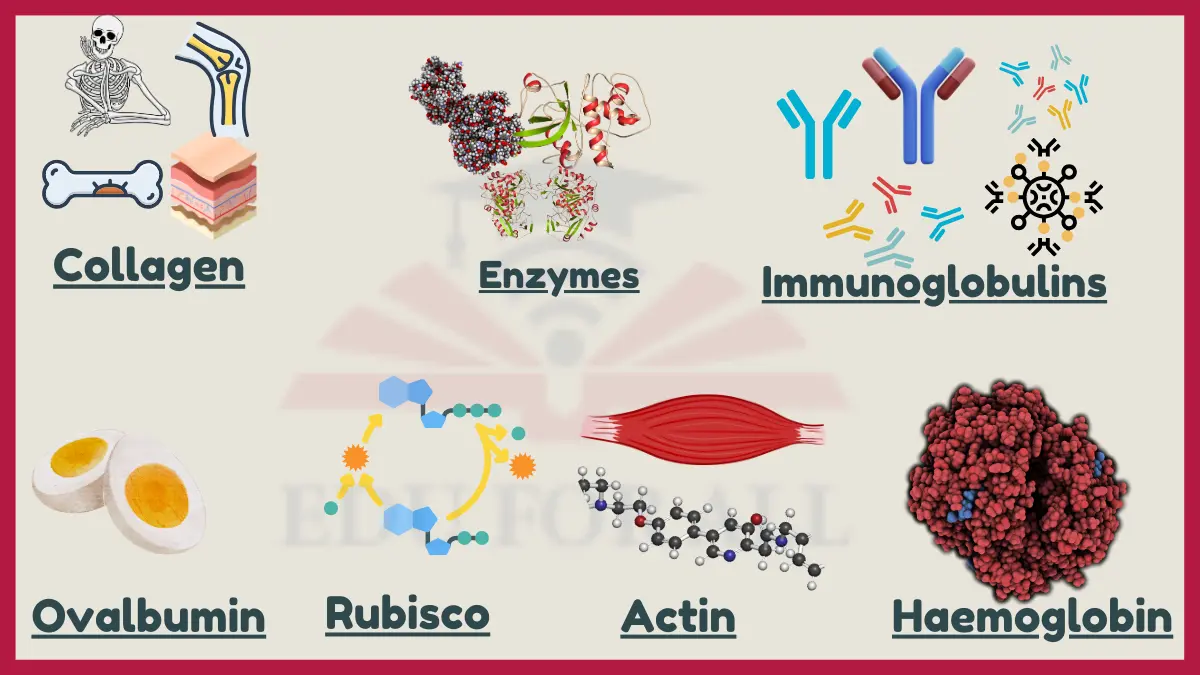Some examples of proteins are hemoglobin, which carries oxygen in the blood; collagen, which provides structure to bones and skin; and insulin, which regulates blood sugar levels.
The Enzymes, receptors, transporters, structural proteins, motor proteins, and storage proteins are also examples of proteins.

- Examples of Proteins
- 1. Collagen
- 2. Actin
- 3. Myoglobin
- 4. Insulin
- 5. Aquaporins
- 6. Sodium-potassium pump
- 7. Keratin
- 8. Rhodopsin
- 9. Kinesin
- 10. Casein
- 11. Ovalbumin
- 12. Rubisco
- 13. Immunoglobulins
- 14. Protein kinases
- 15. Green fluorescent protein
- 16. Motor proteins
- 17. G protein-coupled receptors
- 18. Protease enzymes
- 19. Citric acid cycle enzymes
- 20. Troponin
Examples of Proteins
Here are some important examples of Proteins:
1. Collagen
Collagen is the most abundant protein in the human body. This fibrous structural protein provides strength and elasticity to connective tissues including skin, bone, tendons, ligaments, and cartilage. There are at least 16 different types of collagen composed of three polypeptide chains wound together.
2. Actin
Actin filaments are a major component of the cytoskeleton that helps provide cell shape and integrity. Actin also interacts with myosin to enable muscle contraction. Globular actin monomers polymerize into polar filaments that can generate force when they slide past each other.
3. Myoglobin
Myoglobin is an oxygen-binding protein found in muscle tissues. It contains heme groups that bind oxygen, allowing it to facilitate intracellular oxygen storage and transport. Myoglobin gives meat its red color and is related to hemoglobin in blood.
4. Insulin
Insulin is a peptide hormone secreted by pancreatic beta cells that allows cells to take up and utilize glucose from the bloodstream. It regulates blood sugar levels and the metabolism of carbohydrates, fats, and proteins. Insulin deficiency leads to diabetes mellitus.
5. Aquaporins
Aquaporins are membrane-bound transporter proteins that allow the passage of water molecules across the lipid bilayer, but not ions or other solutes. They facilitate osmoregulation and water balance in cells of organisms from bacteria to humans.
6. Sodium-potassium pump
The sodium-potassium pump is an active transporter that moves sodium and potassium ions against their concentration gradients to maintain membrane potential. The pump hydrolyzes ATP to exchange intracellular Na+ for extracellular K+.
7. Keratin
Keratin is a fibrous structural protein that gives hair, nails, feathers, horns, and claws their toughness and water-resistant properties. It is highly stable due to extensive disulfide bonding between cysteine amino acids. Different keratin types occur in epithelial cells.
8. Rhodopsin
Rhodopsin is a transmembrane receptor protein in the retina that senses light and triggers electrical signals to the brain. It contains a photoreactive chromophore derived from vitamin A that changes configuration when struck by photons.
9. Kinesin
Kinesin motor proteins use ATP-derived energy to transport vesicles and organelles along microtubule tracks within cells. Kinesins play essential roles in neuronal transport, mitosis, signal transduction, and more. They can move cargo over 1 μm per step.
10. Casein
Casein proteins are the predominant milk proteins, making up about 80% of proteins in bovine milk. They transport calcium, phosphate, and minerals and slow down gastric emptying. Casein forms dense micelles due to hydrophobic interactions.
11. Ovalbumin
Ovalbumin is the main protein found in egg whites, accounting for over 50% of their total protein content. This phosphoglycoprotein provides amino acids for embryonic development. Its globular structure denatures upon cooking.
12. Rubisco
Ribulose-1,5-bisphosphate carboxylase/oxygenase, or Rubisco, catalyzes carbon fixation in plants. This enzyme captures atmospheric CO2 to add to ribulose bisphosphate, producing 2 glycerate 3-phosphate molecules in the Calvin cycle.
13. Immunoglobulins
Immunoglobulins, also called antibodies, are secreted by plasma cells of the immune system to identify and neutralize foreign antigens like bacteria or viruses. Their Y-shaped monomers contain two antigen-binding sites.
14. Protein kinases
Protein kinases phosphorylate other proteins by transferring a phosphate group from ATP to a serine, threonine, or tyrosine amino acid. Kinase signaling cascades control cell metabolism, proliferation, survival, and differentiation.
15. Green fluorescent protein
Green fluorescent protein (GFP) naturally emits green light. GFP from the jellyfish Aequorea victoria is used extensively as a reporter for monitoring gene expression and protein localization in cells and organisms.
16. Motor proteins
Motor proteins like dynein and kinesin use ATP hydrolysis to move cellular cargo along microtubule tracks. Dynein moves toward the minus end while most kinesins move toward the plus end of microtubules.
17. G protein-coupled receptors
G protein-coupled receptors (GPCRs) are seven transmembrane proteins that activate trimeric G proteins in response to extracellular signals like hormones or neurotransmitters. They regulate many signaling cascades.
18. Protease enzymes
Proteases are enzymes that break down proteins by hydrolyzing the peptide bonds between amino acids. They have key roles in the digestion of proteins in food as well as intracellular protein catabolism and regulation.
19. Citric acid cycle enzymes
The citric acid cycle uses a series of catalytic enzymes to oxidize acetate from carbohydrates, fats, and proteins into CO2 while generating ATP. These include citrate synthase, aconitase, isocitrate dehydrogenase, α-ketoglutarate dehydrogenase, succinyl CoA synthetase, etc.
20. Troponin
Troponin is a complex of three globular proteins integral to muscle contraction in skeletal and cardiac muscles. It regulates interactions between actin and myosin in response to calcium influx during muscle activation.

